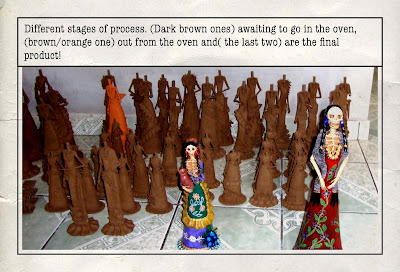Capula Michoacan is a relative small village close to Morelia (the state's capital). This is what I call the home of the Catrinas.
It's in this village that the most beautiful terracota pottery and Catrinas are created.
Capula has it's own replica of the Outback, from where I assume, they get the source material for their creations.
I have always been amazed by the beauty and significance of these pieces, that being said, needless to say that I'm a collector. Not so far ago, I had the chance to experience not only the making of these marvelous pieces, but also to participate! Artisan, Hugo Hernandez and his wife Valentina were kind to invite me. This process was relatively long, since you first have to create the mud clay, make the model, allow it to air dry some days before putting it in the mud oven; and finally, painting it.
I remained on my task and followed it, although I must confess that I wasn't totally equipped (didn't have with me a good quality device for the photos) all the times.
Below I'll try to describe the making process, to make people aware when they see a piece as such.. first to recognize if it's from Capula, and second, to make people aware of the hard and elaborate work it takes... so we don't start bargaining for a reduction. These people rely on the sales for their income and well deserve what they charge for.
The Making
1. The primary element for the Catrinas, is mud/clay. This is easily acquired, since the land is rich in a good quality (mud). As I was told and saw in the making, they prepare different consistence muds, each one will be best for a specific part of the creation (body, details, fingers, etc.).
2. As if we are making pizza, the mud clay also has to be flattened with a special and very heavy object (shown on pic). Although I wished it would be as fast for the pizza dough, this is not the case and takes a while to make the desired are flat and of the same thickness. On the image below, Hugo flattens the clay and lays it flat on his working table.
2. As if we are making pizza, the mud clay also has to be flattened with a special and very heavy object (shown on pic). Although I wished it would be as fast for the pizza dough, this is not the case and takes a while to make the desired are flat and of the same thickness. On the image below, Hugo flattens the clay and lays it flat on his working table.

3. Once flattened, two equal layers are positioned, each on a mold. Then, the two pieces are pressed tightly one against the other and tied up. They will stay like that for some days until the two parts are perfectly united.
Here is abetter view of how it looks once the piece is unmoulded (inverted), only bust, and the lower part.
Here is abetter view of how it looks once the piece is unmoulded (inverted), only bust, and the lower part.
4. Once the piece is unified, it is left to air dry. This mold will serve as central body where the neck, head, arms, hands and details of the dress will be hand made and added.
 The head, neck, skeleton lungs, long thin arms and detailed fingers for each Catrina are created.
The head, neck, skeleton lungs, long thin arms and detailed fingers for each Catrina are created.
For the hair and fingers, which I considered the hardest of all, small thin sticks of mud are made. They are used to braid the hair into beautiful 'trenzas', earrings, hats, feathers and anything else that they feel on the mood to create.

5. As for the body of the Catrina, flounces, flowers, bags, rebozos and even animals (for the Frida's catrina) are placed onto the body.
 The head, neck, skeleton lungs, long thin arms and detailed fingers for each Catrina are created.
The head, neck, skeleton lungs, long thin arms and detailed fingers for each Catrina are created.For the hair and fingers, which I considered the hardest of all, small thin sticks of mud are made. They are used to braid the hair into beautiful 'trenzas', earrings, hats, feathers and anything else that they feel on the mood to create.

5. As for the body of the Catrina, flounces, flowers, bags, rebozos and even animals (for the Frida's catrina) are placed onto the body.
This is how Hugo is customizing a huge meter-long Catrina. He's done the skeleton chest, the neck, added the arms and fingers...
6. It is until they make enough pieces, that they will place them in the oven to 'cook' them.
Hugo and Vale use a self-made mud oven for their pieces. It's amazing!
Once the pieces are 'cooked/heated' they remain there until they are ready to be painted...
In the case you are interested in contacting Hugo, send me an email and I'll send you his information.


















Comments
Post a Comment